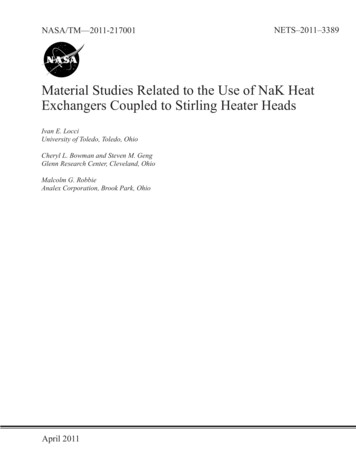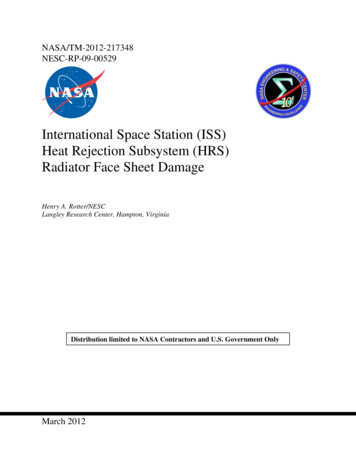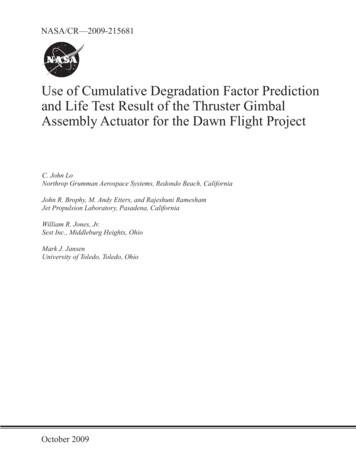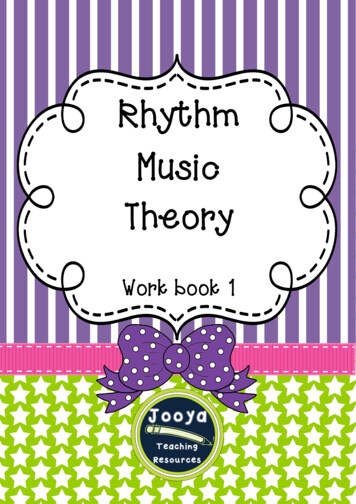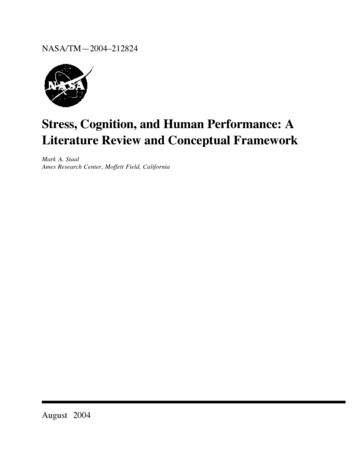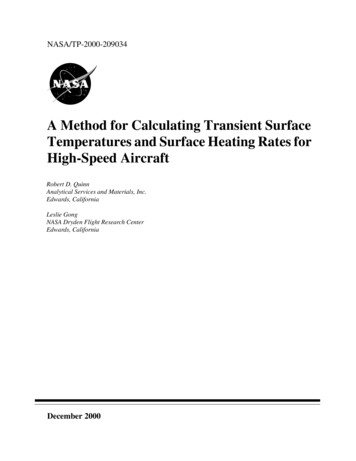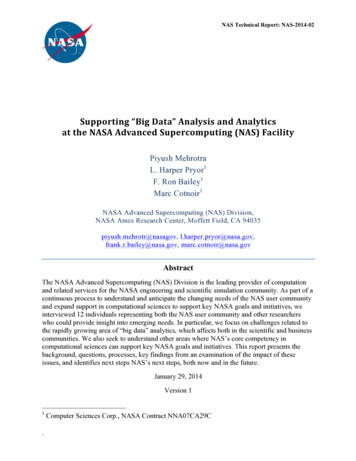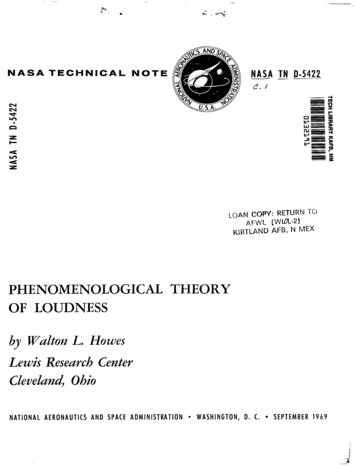
Transcription
""N A S A T E C H N I C A L NOTENASA TN D-5422e. I"LOAN COPY: RETURN TOAFWL ( W m - 2 )KIRTLAND AFB,N MEXPHENOMENOLOGICAL THEORYOF LOUDNESSby Walton L. HowesLewis Research CenterCleveland,OhioN A T I O N A AL E R O N A U T I C SA N DS P A C EA D M I N I S T R A T I O NW A S H I N G T O N , D. C.SEPTEMBER 1 9 6 9
TECH LIBRARY KAFB, NMPHENOMENOLOGICAL THEORY OF LOUDNESSBy Walton L. HowesLewis Research CenterCleveland, OhioNATIONAL AERONAUTICS AND SPACE ADMINISTRATIONFor saleIby the Clearinghouse for Federal Scientific and Technical InformationSpringfield, Virginia 22151 - CFSTI price 3.00
ABSTRACTAlternative time- and frequency-domain equations are presented for predicting theloudness of a wide variety of statistically stationary and nonstationary sounds, eithercontinuous or discontinuous. Zwislocki's theoryof temporal summation and S. S.Stevens' psychoacoustic conversion law are incorporated in the present mathematicaltheory. Frequency domain formulasof Zepler and Hare1 for impulsive sonic booms andJones for steady noise represent specializations of the present formulas. For sinusoidal inputs, modified Fletcher-Munson auditory response curves are predicted. For animpulsive input the measured response is also predicted.ii
PHENOMENOLOGICAL THEORY OF LOUDNESSby Walton L HowesLewis Research CenterSUMMARYA unified theory is derived which should permit the loudness of most sounds, continuous anddiscontinuous, to be predicted from known time or frequency characteristics of the sound. It isassumed that the input sound intensity averaged over a finite time is uniquely related to loudness.This relation is modified to include operational processes by which the human auditory systemconverts intensity into loudness. The processesby which the input pressure signal is transmittedto the brain are assumed to be linear. However, the conversion from a physical (neurological)signal into psychological response (loudness), which occurs in the brain, is nonlinear.Physically, the input sound pressure wave is linearly converted in successive steps into anelectrical wave, which reproduces the original waveform, by hair cells within the organ of Corti.Next, the auditory nerve endings respond to the time rate of change of this current rather than tothe current itself. The resulting information is transmitted to the brain along the auditory nerve.This information is evaluated in the brain and subjectively interpreted as loudness.Mathematically, the time domain representation of the current output of the hair cells is aFourier convolution of the impulse response of the entire preceding system with the original inputsound. The response of the auditory nerve endings corresponds to time differentiation of theFourier convolution. The signal transmitted to the brain contains information regarding "elect r i c power, t which is assumed to be uniquely related to loudness. The loudness is a function ofa finite-time integral of the power. The conversion from physical output to psychoacoustic response is accomplished by using s. s. Stevens' psychoacoustic conversion law. The frequencydomain representations of these processes are derived by using Fourier series and transforms.The fact that the loudness is a function taken over finite times implies that the frequency representations can be written in terms of "running" Fourier transforms. The complete history of theloudness is predicted.The complete auditory system must act as a nonideal, band-pass, filter. The responseof aselected filter characterizes the system. Part of the selected response function may be attributed to the time differentiation process. The rest of the function is a generalization of that obtained by Zwislocki in his theory of temporal auditory summation. Thus, Zwislocki's theoryisimplicit in the present one.The present theory was tested using two fundamental inputs, sine waves and impulses. Forsine wave inputs the theory predicts the Fletcher-Munson frequency response curves minus a diffraction correction for the disturbance created by the human head. For impulsive inputs thetheory predicts loudness proportional to the intensity, as measured.Frequency domain formulas of Zepler and Hare1 for' impulsive sonicbooms and Jones forsteady noise represent specializationsof the present formulas.
INTRODUCTIONWell-known empirical methods exist for predicting the loudness of certain statistically stationary sounds (refs. 1 to 3), that is, of certain sounds whose statistics are independent of time. Methods for predicting the loudness of certain statistically nonstationary sounds may be less well known (refs. 4 to 6). No means exists for predicting theloudness of all sounds of either statistical class. Moreover, no single scheme has beenshown to predict correctly the loudness of some sounds in both classes. The main deterrent in developing a unified theory of loudness appears to be an impression that thecomplete auditory system is so complex that a concise mathematical representation ofthe entire system is not feasible (ref. 6), and that, because the psychoacoustic responseto an acoustic input is highly nonlinear, Fourier analysis is not readily applicable to theentire system (refs. 6 and 7). Thus, there would seem to be an inherent difficulty in relating time and frequency representations of psychoacoustic response to a given acousticinput. The main purpose of this report is to show that a practical unified theory of loudness based on Fourier methods is possible and that the theory proposed herein leads topredictions in good agreement with experiment.The theory to be described resulted from a desire to obtain alternative time andfrequency descriptions of the loudness of sonic booms produced by supersonic aircraft.reSuch a theory might be useful in determining the extent to which undesirable humansponse to sonic booms could be minimized by controlling the boom pressure signature(ref. 8). The present theory appears to have much broader validity than originally intended.There are at least three forms of theory which might be developed, namely, onebased on the physics and psychophysiology of the ear, nervous system and brain, a phenomenological theory in which the major elements of the complete auditory system arerepresented by simplified mathematical models, or a completely empirical theory inwhich each input is directly associated with an ultimate output response as determinedexperimentally. The first form of theory is likely to get bogged down by physical andmathematical complexities. The last form of theory (empirical) is ,likely to be impractical because new response tests would have to be performed for each new waveform. Itis not likely that such a theory would improve understanding of the hearing process.However, in cases where very rapid pressure changes are the overwhelming determinantof response (as in the case of sonic booms), the empirical approach may still prove completely satisfactory for engineering calculations. Herein the phenomenological approachhas been adopted with the hope that it will lead to reasonably accurate estimates of response to a variety of input signatures based on simple mathematical representations ofthe operational characteristics of the human auditory system.The complete auditory system consists of three principal elements: the ear, thenervous system, and the brain (fig.1). The primary operational functions of the ear,2
\Mildle\\Inner\ ear\\.r Ovalwindow/ainu-Eardrum-/CD-10438-04Figure 1. -Auditory system.nervous system, and brain are assumed to be, respectively, pressure amplification;physical conversion, filtering and time differentiation; and autocorrelation and ?psycho2). The "physical conversion"is from a sound wave tophysical conversion" (fig.mechanical pressure to a hydrodynamic wave and, finally, to an electrical wave. "Filtering" simply implies that all the energy of the incident sound waves is not transmittedto the brain. "Autocorrelation" concisely describes the mathematical processof inteis ingrating the "power" with respect to time. The term "psychophysical conversion"tended to imply the conversion of a signal magnitude from objective, physical measure tois, from physical intensity to loudness in thesubjective, psychological measure; thatcase of statistically stationary sounds.In the ear (refs. 3 and 9 to 11) (see fig. 1) the sound pressure fluctuations in the atmosphere are mechanically amplified by the eardrum and ossicles into hydrodynamicpressure waves within the cochlea. The conversion into hydraulic waves occursat theoval window. Within the cochlea the hydraulic pressure waves are further converted intoelectrical waves by hair cells in the organ of Corti. These waves are reproductions ofthe original sound pressure waveform (ref. 3, p. 109f). At the auditory nerve endings,the electrical waves are then encoded as electrical impulses of uniform amplitude whichare transmitted to the brain througha bundle of nerve fibers comprising the auditorynerve. It appears from the uniform amplitude pulse code signals that.the auditory nervecan be regarded as a lossless transmission line. The amplitude of the electrical wavemust exceed a certain threshold value in order to produce an impulse in the auditorynerve. But most importantly the time rate of change of the electrical signal determinesthe number of nerve fibers along which the impulses will be transmitted (ref. 3, p. 112).
The continued change of wave amplitude produces successive impulses in each nervefiber. The number of fibers which transmit impulses to the brain determines theloudness of the original sound, as subjectively interpreted in the brain. It seems reasonableto expect that the concept of "electric power" (output from the hair cells) can be associated with one aspect of the information transmitted to the brain and that thispower integrated over a finite time duration is uniquely related to loudness. The well-known timeintegration of the signal probably occurs in the brain.The preceding paragraphs outline the processes that will serveas the basis for atheory of loudness. Although the various mathematical operations will be associatedwith specific elements of the auditory system, possible incorrect associations (ref. 11)are not likely to affect the theoryas long as the assumed operations do occur essentiallyin the order described.isThe theory will be developed according to the following procedure. The loudnessassumed to be uniquely related to the sound intensity integrated over a finite time, theauditory integration time. This average sound intensity is expressed as a function of thesound pressure history (time domain), or, alternatively, as a function of the sound pressure spectrum (frequency domain). (The time and frequency domain analyses will bepresented consecutively, rather than in parallel. ) Next, the operational characteristics(pressure amplification, physical conversion, filtering, and time differentiation)of theauditory system are introduced. Information regarding the original sound intensity ultimately appears in the brain as information regarding the finite-time-average electricpower reaching the auditory nerve. This poweris expressed mathematically in bothtime- and frequency-domain representations. The power formulais made more explicitby specifying the filter characteristics of the auditory system in analytical form. Finally, the psychoacoustic response called loudness is related to the power by applyingStevens' law (ref. 12). This completes the process of relating the sound pressure toAuditorycomponent:pressureForm of signal:pressureSoundpressureOperationalprocess:In time domain:Organ of Corti(hair ntElectricimpulsesPhysical -pass filter) p(t) peaj(t) K/,th(t -Figure 2. - Proposed model of auditory system.4AuditorynerveSubjective loudnessDifferentiation Time integration andpsycho(high-pass filter) physicalconversion
loudness through a chain of operations which presumably occur in the auditory systemand brain.The succession of auditory components, the operational processes they perform,and the corresponding physical and mathematical representations of the processes arediagramed in figure 2.PHYSICAL QUANTITIES RELATED TO LOUDNESSIt is assumed that the subjective psychoacoustic quality called loudnessis a singlevalued function of the finite-time-averaged intensity of the sound input at the ear.S. Lifshitz (ref. 13) appears to have been the first to propose this relation. Its validityis well established (refs. 1, 3, 12, 14, and 15). Specifically,the average acoustic intensity over all time (average energy flux overall time),"Q pvnusually serves as a physical measure uniquely associated with loudness. In equation (l),p is the acoustic pressure, vn is the normal component of acoustic particle velocitythrough a control surface having unit area, and the overbars denote infinite time averages. (All symbols are defined in appendix A. ) At distances from the sound sourcewhich are large in comparison with the extent of the source, equation (1) is approximatedby the well-known plane-wave relationwhich in more detailed form is written aswhere t is time, p is the atmospheric density, and c is the speed of sound. For stationary sounds, equation (3) determ.ines an adequate physical measure of loudness. However, for momentary sounds, such as sonic booms, the intensity-9 averaged over alltime is an unsatisfactory physical measure of loudness because 9 may vanish. Evenfor statistically stationary sounds, practical necessity requires that the averaging timebe finite. In audition a close approximation to 5,both physically and psychologically,is obtained for averaging times less than a second. Let 5 denote this average, where5
.the tilde indicates that the average is taken over a finite time duration tl.erage intensityThen the av-is a practical physical measure of loudness for continuous sounds, regardless of their5 is independtime dependence (i. e., statistics). For statistically stationary sounds,ent of t.Equation (4) as it stands cannot be correct, or at least complete. To illustrate this,consider the following example. Suppose that throughout an arbitrary auditory integration interval tl, p(t) Constant # 0. Equation (4) indicates that the auditory responsewould be nonvanishing and, hence, that auditory response occurs.In fact, auditory response does not occur in this circumstance. Thus, equation(4) must be incomplete, orincorrect. This difficulty will be eliminated when the operational characteristics of thehuman auditory system are considered.PHY SlCAL INPUT-OUTPUT RELATIONSEquation (4)is incomplete because it does not include operational characteristics ofthe auditory system; namely, the pressure amplification induced in the middle ear, thephysical conversion from a pressure signal to an electrical signalby the hair cells inthe inner ear, and the response to time rates of change of electrical current by the auditory nerve endings. By assuming that these processes are linear, they can be readilytreated analytically. (Linearity was previously assumed in the loudness theory of B k k ,Kotowski,and Lichte (ref. 5) and is indicated by measurements (ref. 3, p. 110).)The successive operations performed by the auditory system involve transfer functions which relate the input and output signal amplitudes. Because the auditory systemdoes not constitute an all-pass filter, part of the energy of the input signal does notas a quasi-linear bandreach the brain. The complete auditory system acts essentiallypass filter. For humans the passband extends roughly from 20 t o 20 000 hertz. Anylinear filter is characterized by two alternative quantities; namely, the frequency response function H(w) and its Fourier transform, the impulse response function h(t).Specifically,H(w) 6lmmh(t)e-iwt dt-
which may be denoted bywhere o is the angular frequency. The frequency response functionthe filter output for a sinusoidal input; the impulse response functionfilter output for an impulsive input (delta function).H(w) describesh(t) describes the.Time-Domain AnalysisThe hydrodynamic pressure fluctuations in the cochlea are assumed tobe proportional to the input atmospheric pressure fluctuations. Next in succession, the electricaloutput of the hair cells in the inner ear is assumed to be proportional to the hydrodynamic pressure fluctuations. These proportionality constants can be lumped into asingle constant K . Hence, for an arbitrary sound pressure inputp(t) to this linear system, the resulting electric current output j(t) from the hair cells is simply given(ref. 16, p. 83) in the time domain byj(t) K/coh(t - T)P(T)dT-mwhich are alternative expressions. The currentj(t) reaches the auditory nerve endings.But the auditory nerve endings respond to the time rate of change of this current (ref. 3,pp. 112, 259), rather than to the current itself. Thus, the information transmitted tothe brain along the auditory nerve concerns7
1rather than j(t).At the outset it was emphasized that loudness is uniquely related to the intensity ofthe sound input. After the hydrodynamic wave is converted into an electrical wave, elect r i c power n, which is proportional to the acoustic intensity 'k, replaces intensity asthe appropriate physical measure of loudness. The outpEt of the hair cells is a reproin parallelism with equation (4), theduction of the original sound waveform. Thus,finite-time-average electric power output of the hair cells IIc(t) is given byNwhere an electrical resistance R has been introduced to give the equation dimensions ofpower. When the response characteristics of the auditory nerve endings are included,equation (9) must be replaced by2drdwhere 5 j(7) is given by equations (8). Tnformation regarding this power is transmitted to the brain along the auditory nerve. The mode of transmission is essentiallylossless and need not be specified in the present theory.In summary, equations (8) and (10) relate the input sound pressure to the electricpower reaching the auditory nerve. Information regarding this power is transmitted tothe brain, wherein the information is interpreted as possessing the subjective qualitycalled loudness.The preceding theory is specified in the time domain. The corresponding resultswill now be derived for the frequency domain.Frequency-Domain AnalysisIn the frequency-domain representation, the electric power is to be expressed as afunction of the sound pressure spectrum P(w),which is the Fourier transform of thesound pressure history, o r signature p(t). In other words,8
Because the auditory integration period tl is finite, the nature of the sound pressurespectrum after passage of a finite time may sometimes be of interest. This so-called(?runningffspectrum P(0, t) is given by (ref. 16, p. 148f)P ( w , t) ft p(-r)e-iWTd7--ooorwhereAlso,The running pressure spectrumically,P ( w , t) is a function of P ( w ) (ref. 16, p. 149). Specif-relates the two spectra, where6 is the unit impulse function.Tn particular,Similar relations apply for the current. Thus, the current possessesgiven byas well as a running spectrum,J(w, t)-O ( t - 7)j(7)a spectrum J(w)
Equations (15) and (16), with P replaced by J, also apply.In the time-domain representation, the current is related to the pressure accordingto equation (7). The corresponding frequency-domain representation is (ref. 16, p. 86)A s shown in appendix B, the running current spectrum maybe expressed in t e r m s of theresponse functions and pressure input byJ(w,t) J(w, t) Kf-m- iwrH(w, t - r)p(r)ed7 J6mh(r)P(w,t - r)e- i w r d7whereand H(w, t) is the running frequency response function. In parallel with equation (16),H(w, t m) H(w). More generally, equation (15) applies with P replaced byH.It is noteworthy that the integrands in equations (20) consist of products of time andfrequencyfunctions. If t03, and h(T) and p(r) 0 as T m, equations (20) reduceto equation (19). Even more importantly from the standpoint of steady noise, ifH(w, t - T ) is effectively constant throughout the interval (-m, t), except for a short timet - T tl (where, as before, tl -isthe auditory integration period), equations (20) reduce to--.-which involves the running spectrum P(w, t), rather than the ordinary spectrum P ( w )contained in equation (19).In determining the electric power, the time derivative of the current, rather thanof thisthe current itself, is most significant. The frequency-domain representationderivative is given by the Fourier transformd j(t)dt10-ioJ(w)
However, the loudness is determined by the electric power integrated over a finite timeinterval tl (cf. eq. (10)). Hence, the running transform of the time derivative applies.The running transform is given byd [0(tdr--r)j(r)]-iwJ(w,t)In expanded form, namelythe left-hand side of equation (24) is seen to include an impulsive transient associatedwith switching off the integration. The existence of this transient is independent of theis not determined by the input.specific time dependence of j(t). Hence, the transientThe transient is not associated with the human auditory system because the human minddetects no subjective loudness of an impulsive nature associated with initiationo r termination of the auditory integration process. The auditory system remains in the "on"state all the time. Thus, this "switching" transient is unphysical and should be omittedin computing the power. The switching transientis purely a consequence of the mathematics of the Fourier transform and does not appear if d j(t) is represented by aFourier series expansion over the periodtl. Finally, equation (lo), the original timedomain equation for the power, does not contain switching transients.With the switching transients eliminated it is shown in appendix C that, in thefrequency-domain representation, the electric power is given byaE(t) 3SglI [ J(o,t)l 2 - I J(o,t - tl) I 2]w2 dw2n--03which, when accompanied by equations (20), expresses the average power as a functionof the input pressure history or its spectrum. Equation (26) exhibits a high-frequencyweighting ( a w 2) of the average power by virtue of the nerve endings' response to theas high-passtime derivative of the current. Thus, the auditory nerve endings actfilters.dThe integral in equation (26) may be divergent. To avoid this difficulty,j(t) inequation (10) may be expanded as a Fourier series over the integration interval. Thepower is ultimately expressed by the sum of the squares of the Fourier coefficients.This approach is especially useful when d j(t) is periodic. The case wherep(t) is apure tone is considered in appendix D. B p(t) is unknown and information is availableaa11
regarding the spectrum, but the integral in equation (26) is divergent, then methods described by Bennett (refs. 17 and 18) may be used to evaluate the power.The resulting power formulas may now be summarized. In the time-domain representation,Tf h(t) and p(t) a r e both real, the absolute value signs in equationbe removed. In the frequency-domain representation,H(o,t- tl -r)p(r)e(27) can, of course,drl]co2doIf the sound input is steady noise and H(w, t - r) is effectively constant, exceptduring the short time interval t - T tl, then equation (22) is valid. Therefore,12(28a)
orfollows from equation (28a), where, by definition,Hc(w) iwH(w)( 30)andd h(t)hc(t) dtH h(t) andp(t) are quasi-impulsive, that is, if h(t)andp(t) a r e nonvanishing onlyover a time period shorter than the integration time tl, then equations (28) simplify.toSuppose that p(t) is initiated at some time to and is quasi-impulsive. Assume thatoccurs within the auditory integration interval, thatis, t - tl 5 to t. Then, the second time integral in equations (28) vanishes. Assume that p(t) effectively vanishes permanently again at some later time t; less than the upper limit of integration, that is,to tb t. Then, if the running frequency response H(w, t) effectively becomes independent of time for time durations t - tb or larger, that is, if H(w, t - t;) H(w), thenH(w, t - 7) may be extracted from the integrand of the first integral in equation (28a).H(w) corresponds to h(T t - tb) 0, and in conjunctionThecondition H(w, t - t;)with causality (to be discussed) implies that h(t) is quasi-impulsive. The remainingt tb, it followsintegral equals P ( w , t). But, because p(t) effectively vanishes forthat P(o,t) x P ( w ) . Hence, equation (28a) reduces toor
Equation (28b) can be reduced to equations (33) by a similar argument.In general, the response Characteristics of the complete auditory system are mathematically entangled with the input pressure. However,in the special case of equations(29) and (33), the response characteristics are separable from the input. Thus, thequantities h,(t) and Hc(w) represent the response functions for the complete auditorysystem preceding the auditory nerve.CAUSALITY AND THE PALEY-WIENER THEOREMTn the preceding section the electrical poweroutput was related to the sound press u r e input by introducing response characteristics of the auditory system. The nextstep is to specify the response characteristics explicitly.However, before doing s o itis important to consider the consequences of causality and the Paley- Wiener theorem inthis regard. The Paley-Wiener theorem not only has a bearing on the response characteristics but also provides an important result regarding the spectra of short durationsounds.First, considercausality.Causeprecedeseffect.Thus,if p(t) is initiated atsome time t to, then j(t) 0 for t to. Without loss of generality, one can sett0 0.A functionwhichvanishesfort 0 is called causal (ref. 16, p. 13). The impulseresponse h(t) is causal (ref. 16, p. 85).Hence,H(w, t) is also causal. It followsfromequations (7)and (20), respectively, thatj(t) and J(w, t) must be causal.Causality in conjunction with the Paley-Wiener theorem (ref. 19,p. 16ff or ref. 16,pp. 215-217 and 222) leads to important consequences regarding the auditory responsecharacteristics as well as the spectra of finite duration sounds. The Paley-Wiener theorem states that, ifwhere F(w) is square integrable, thatis,then f(t), which is the Fourier transform of F(w), is causal. Note that, if F(w) vanAw, the inequality (eq. (34)) is violated. Thereishes over any nonvanishing interval14
fore, the spectrum of any causal function must be nonvanishing at all, except possiblediscrete, frequencies if the spectrum satisfies the inequality (eq. (35)).Let the auditory impulse response h(t) correspond to f(t) and the frequency response H(w) correspond to F(w). From the Paley-Wiener theorem it follows that, beH(w) must be nonvanishcause h(t) is causal, the auditory frequency-response functioning for all, except possible discrete, frequencies. This means that the auditory response cannot be represented by a simple ideal band-pass filter (ref. 20).Let the electric current j(t) correspond to f(t) and the current spectrum J(w) correspond to F(w). Then,because j(t) is causal and J(o) is square integrable for finitesignal amplitudes, the electrical output of the hair cells associated with any soundinputmust include all, except possible discrete, frequencies in the audible range.Finally, let the sound pressure p(t) correspond to f(t) and the pressure spectrumP(0) correspond to F(o). If p(t) is causal and P ( w ) is square integrable, P ( w ) mustboom reprebe nonvanishing for all, except possible discrete, frequencies. The sonicsents an important sound satisfying the Paley-Wiener conditions.Hence, the production.of an inaudible sonic boom is impossible. This conclusion is reached without even takingaccount of the auditory system.In the preceding applications of the Paley-Wiener theorem the results are valid inprinciple. However, the amplitudesof the response functions or signals have not beenconsidered. By definition, the response functions vanish outside the audible frequencyrange. Inside the audible range the signals may be too weak to produce any response.EXPLICIT FILTER CHARACTERISTICS OF THE AUDITORY SYSTEMThe filter characteristics of the auditory system can nowbe specified explicitly. Inequations (30) and (31) the response characteristics of the complete auditory system,namelyhc(t)andHc(w), havebeenspecified as functions of h(t)and H(o). Becausethe auditory system is assumed to perform linear filtering, it represents a stable syst e m in the sense that its response to any bounded input is bounded. This implies thathc(t) is absolutely integrable, that is,-or hc(t)Iw I-c- -.0 faster than l/t as tIf hc(t) is absolutelyintegrable,by virtue of the Riemann-Lebesgue Lemma (ref. 21), namely-cHc(w)-0as15
-.,,,,.,.-., ,.--.---hc(t)e-iwt dt Because the human sensory system is excited only by time-dependent inputs, it followsthat Hc(0) 0. Thequantity Hc(w) must, therefore, describea band-passfilter.Thehuman auditory system as a passive filter is causal. The causality condition in conjunction with the Paley-Wiener theorem indicates that the auditory response cannot be characterized by an ideal band-pass filter because the impulse response of such a filter isacausal. The impulse responseat time t 0 is given byhc(0) 1Hc(w)dw7Twhich follows from equation (32) and causality and where /?e denotes the real part.Because the auditory response is nonvanishingin the audible frequency pass-band,itfollows that /?e Hc(w) 0 f o r 0 w 00 because /?eHc(w) cannot change sign.Hence,I1.To summarize: In attempting to relate its time- and frequency-response characteristics,the complete auditory system as a linear system corresponds to a nonideal, band-pass,filter. The associated response to an infinite impulse is necessarily nonvanishing at theinstant the impulse is applied, but vanishes faster than l/t as t00.The preceding arguments apply with respect to th
PHENOMENOLOGICAL THEORY OF LOUDNESS by Walton L Howes Lewis Research Center SUMMARY A unified theory is derived which should permit the loudness of most sounds, continuous and discontinuous, to be predicted from known time or frequency characteristics of the sound.It is assumed that the input


